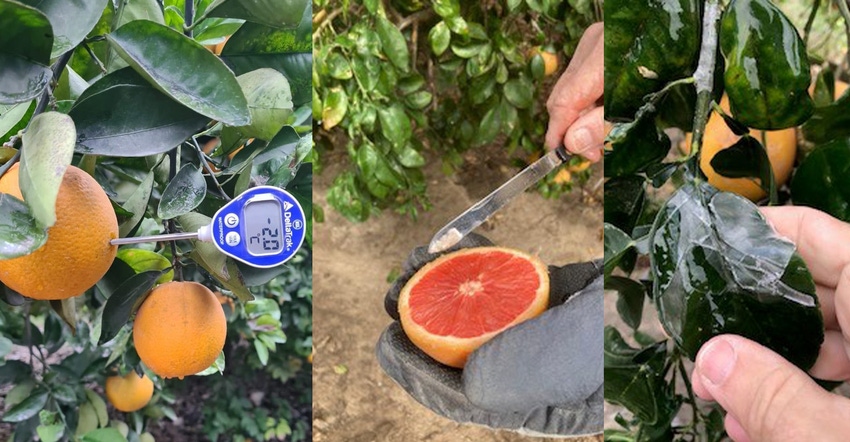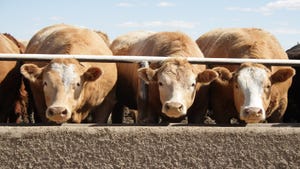
"Mind-numbing," is how Dale Murden, citrus producer and president of Texas Citrus Mutual, describes the last 11 months in the Rio Grande Valley (RGV). From five months of lingering drought to being hit by Hurricane Hanna in July and last week's St. Valentine's Day Massacre, all "on top of a pandemic," Murden admits production in his region has been challenging, to say the least.
The St. Valentine's Day Massacre is how Murden identifies the latest casualty in his region, referring to last week's 50 hours of freezing temperatures which destroyed much of the RGV fruit and vegetable crop.
"We had a stretch where we had four hours at 21 degrees—that's critical," Murden says. "It's still a little early to assess tree damage, but as far as the citrus industry goes, we've got about 55% of our grapefruit crop remaining on the tree and 98% of our Valencia orange crop remaining, that's about a $78 million loss."
Feb. 14 through Feb. 17, Rio Grande Valley temperatures dropped below 27 degrees, with a high of about 30 degrees Feb. 15. Feb. 18, temperatures rose above freezing, only to drop again for two additional days, according to AccuWeather.com.
"Fruit will typically start freezing inside about five hours into a 28-degree period, so with all those temperatures under 28 degrees, you can imagine what the inside of the fruit looks like. I'm not saying it's all damaged, there's probably pockets of fruit that are salvageable, but by and large, it's a disaster industry-wide."
The massacre also hurt the 2022 crop. "The problem is with bloom, that's next year's crop. That could be a total loss, too, depending on the damage to the tree. We lost the bloom that was already in bloom and as we cut the trees back, as far back as they died, we won't bloom without new growth. No bloom. No fruit. That's another $225 million and we haven't even begun to address tree loss yet."
"We're possibly out of a crop for this year and next. It's a 'wait and see' on our tree damage at this point."
What can be seen on the trees is 1-inch diameter wood with splits, which Murden says will die back. "I'm hoping it doesn't go any further to the main scaffold branches or the trunk. If we start to see splits on the trunk then that means the tree is going to have to be replaced. I'm hoping that's not the case, but it will take a couple of weeks to determine."
Power outages and no water for days further compounded an already miserable week, Murden says. "Before the freeze hit, the packing sheds had citrus in them. They were without power, so they were unable to grade or pack and ship that fruit for several days. Our juice plant, where we would salvage some of this fruit, was asked to shut off their natural gas in order to supply it to homes. So, we didn't have the ability to salvage some of this fruit because of that."
Murden is hopeful operations will return to normal quickly.
Insurance
Citrus producers have different levels of crop and tree insurance but as Murden said, "insurance was never meant to make you whole." While it softens the blow, he said it's not going to pay rehabilitation costs.
"I'm not complaining but I think a lot people misunderstand that crop insurance is like any other insurance, it doesn't pay 100% of the disaster. It just helps you get through tough times. There's a lot of work in rehabilitating the groves that we'll have to figure out how to finance and normal grove care work going forward."
Grove care costs average more than $3,000 per acre, "that's whether I grow a crop to sell or not, I've still got to care for the grove like I should, good husbandry, et cetera," Murden says.
Not the first
This is not the first time freezing temperatures have destroyed citrus production in the Rio Grande Valley. The freezes of 1983 and 1989 lasted a long time, Murden recalls, with temperatures lingering in the teens. "Hopefully we won't lose trees like we did in 83 and 89. Those were complete wipeouts. We, as an industry, had to basically start over. Citrus is a long-term investment. You plant a tree and it takes about five years before you start to see any income."
Warm-up
Over the weekend and throughout this week, temperatures will be in the 80s, causing even more issues. "When you go from 21 degrees to 80, you've got all that sap in the tree, it'll start to show. The leaves will defoliate, and the remaining crop will start to fall on the ground pretty quickly."
Disaster declaration
Murden and area producers have been assessing and photographing damage to report to their officials. "We've got the disaster declaration and it's already gone up to USDA, so hopefully, if there's going to be any disaster benefits moving forward, we can work with them and find the right programs that will help growers."
In the meantime, he hopes consumers don't forget them. "One thing as a grower that concerns me is when you're out of the marketplace for one or two years, people forget you and you get replaced by some other commodity. We hope that the consumer sticks with us and when we're back, they support us."
To learn more
AgriLife Extension will host three free online educational opportunities for those interested in how the winter storm has affected fruit trees as well as ornamental plants, turfgrass and other landscaping plants and trees. Those webinars and their times are as follows:
Plants – Will they Survive the Winter Blast? hosted by The Gardens at Texas A&M University and Aggie Horticulture will be presented on Facebook Live 1 p.m. Feb. 24.
Texas Winter Blast – Impacts on your Home Fruit Production, hosted by The Gardens at Texas A&M University and Aggie Horticulture, will be presented on Facebook Live at 1 p.m. Feb. 26.
Urban Landscape Winter Storm Recovery, presented by AgriLife Extension specialists and agents on the Zoom platform, will be presented at 4 p.m. Feb. 26.
About the Author(s)
You May Also Like






